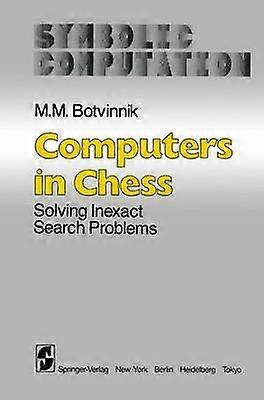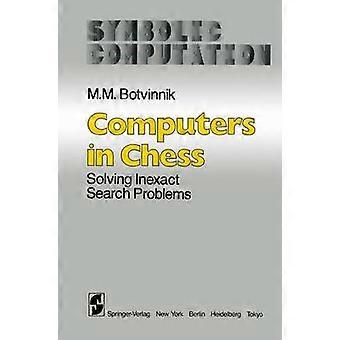Description
1 The General Statement. - Definition of an Inexact Task. - Inexact Tasks and Control Systems. - Two Methods for Solving Inexact Problems. - The Goal of the Game and the Scoring Function. - Goal and Prognosis (The Optimal Variation). - Multi-level Control Systems. - Types of Multi-level Systems. - Advantages of the General Goal. - The Method for Connecting the Optimal Variations of the Components for Types C and E Regimes. - Computer Programs and Humans. - The Expansion of Artifical Intelligence. - 2 Methods for Limiting the Search Tree. - Truncation. - The Goal of an Inexact Game. - The Scoring Function. - Breaking Off a Variation. - The Pruning of Branches. - The Horizon. - Two Trees: The Mathematical Model (MM). - The Stratification of the System. - Three General Limitation Principles. - Improving the Results of a Search. - 3 The Search for a Solution and Historical Experience. - The Search for a Solution by Association. - The Handbook Method of Searching. - 4 An Example of the Solution of an Inexact Problem (Chess). - A. The Search for a Move in an Original Situation. - B. The Use of Historical Experience. - 5 Three Endgame Studies (An Experiment). - 6 The Second World Championship. - KAISSA-CHESS 4. 6. - Conclusions. - Appendix 1. - Fields of Play (by B. M. Stilman). - 1. The Formation of Fields and the Search Within Them. - 1. 1. The Concept of a Field. - 1. 2. The Search Procedure in the Initial Position. - 1. 3. The Formation of Fields During the SearchAn Example. - 1. 4. Formation of a Field. - 1. 5. Storage of Information about Sheaves of Trajectories in Computer Memory. Linked Lists. - 1. 6. Information on the Trajectories of a Field. - 1. 8. Computing the Length of a Denial Trajectory. - 1. 9. Correction of the Sighting Method. - 1. 10. The Pseudosearch. - 1. 11. The Extent of the Climb Up a Branch in thePseudosearch. - 1. 14. Freezing a Trajectory for Lack of a Connection to an Active One. - 1. 15. Criteria for Freezing. - 1. 16. The Algorithm for Freezing. - 1. 18. Trajectory and Field. - 2. The Choice of Moves in an Ensemble of Fields (The Mathematical Model). - 2. 1. The Goal of the Game and the Ending of a Variation. - 2. 2. The Criteria for Breaking Off a Variation in the Search. - 2. 3. Testing the Criteria for Ending a Variation. - 2. 4. Pruning Branches by the Minimax Principle. On the Branch-and-Bound Method. - 2. 5. Pruning Branches by the Worst Case Method. - 2. 6. Priority of Moves in a Search. - 2. 7. Analysis of the Trajectories of a Sheaf for Inclusion in the Search. - 2. 8. Analysis of Trajectories for Forking. - 2. 9. Retreat and Deblockade. - 2. 10. Pruning in the Presence of Branching in a Sheaf of Trajectories. - 2. 11. The Structure of the Search Tree. - 2. 12. A New Content of Known Procedures. - Appendix 2 The Positional Estimate and Assignment of Priorities (by M. A. Tsfasman and B. M. Stilman). - Appendix 3 The Endgame Library in PIONEER (Using Historical Experience by the Handbook Method and the Outreach Method) (by A. D. YUDIN). - 3. 1. Introduction. - 3. 2. Formulation of the Problem. - 3. 3. Configurations. - 3. 4. The Boundary Effect. Decomposition Formulae. - 3. 5. Symmetries. - 3. 6. The Structure of the Library. Classes. Coding of the Information. - 3. 7. Organization of the Information in the Form of Two-Dimensional Tables with Subordination of Entries. - 3. 8. The Algorithm for Using the Endgame Library (The Search for Exact Coincidence). - 3. 9. Examples of the Operation of the Subroutine for Using the Endgame Library. - 3. 10. Outreach for a Library Position. - 3. 11. The Search for Nearby Positions. - 3. 12. Filter with Respect to the Pawn Structure. - 3. 13. The One Color-DifferentColor Filter. - 3. 14. Filters Within a Set of Positions. - 3. 15. Finding a Group of Neighboring Positions. - 3. 16. Implementation of the Outreach Method. Anti-outreach. - 3. 17. Entry from the Move-Search Routine. - 3. 18. Outreach and Exact Coincidence. - 3. 19. The Potential for Wide Use of Library Rules in PIONEER. - 3. 20. The Breakoff Criterion Based on the Rule of the Square. - 3. 21. Conclusion. - Appendix An Associative Library of Fragments (by A. I. Reznitsky and A. D. Yudin). - References. - Glossary of Terms. - Index of Notation. Language: English
-
Fruugo ID:
337897970-741557341
-
ISBN:
9781461297369
Delivery & Returns
Dispatched within 4 days
Shipping from United Kingdom.
We do our best to ensure that the products that you order are delivered to you in full and according to your specifications. However, should you receive an incomplete order, or items different from the ones you ordered, or there is some other reason why you are not satisfied with the order, you may return the order, or any products included in the order, and receive a full refund for the items. View full return policy

